工作流参考模型英文(doc 36页)
岗位工作流程英文缩写

岗位工作流程英文缩写Job Workflow Abbreviations and Their Importance.In the fast-paced world of business, it's crucial to streamline processes and communicate efficiently. One way to achieve this is through the use of abbreviations and acronyms, which condense complex or lengthy terms into manageable snippets of text. This is particularly relevant when discussing job workflows, as they often involve multiple steps and cross-functional teams. Here, we explore some common abbreviations used in job workflow discussions and their significance.1. WF (Workflow): This abbreviation refers to a series of tasks that need to be completed to achieve a specific goal or outcome. Workflows are often visualized as flowcharts or diagrams to help teams understand the sequence of steps involved.2. KPI (Key Performance Indicator): A metric used tomeasure the success or progress of a workflow. KPIs help identify areas where improvements can be made and ensure that the workflow is aligned with overall business objectives.3. T&A (Task Assignment): This abbreviation refers to the process of assigning specific tasks to individual team members. Effective task assignment ensures that each team member knows their responsibilities and can work independently to complete their assigned tasks.4. SLA (Service Level Agreement): An agreement between two or more parties that specifies the level of service to be provided, including quality, availability, and other performance metrics. SLAs are often used in workflow management to ensure that service providers meet agreed-upon standards.5. BPM (Business Process Management): A discipline that focuses on improving the efficiency and effectiveness of business processes, including workflows. BPM methodologies help organizations identify bottlenecks, eliminate waste,and streamline operations.6. QA (Quality Assurance): The process of ensuring thata product or service meets specified quality standards. In the context of workflows, QA involves checking tasks for accuracy, completeness, and adherence to defined processes.7. RT (Response Time): The time taken to respond to a request or issue. In workflow management, response time is often used as a metric to measure the efficiency of task assignment and resolution.8. ESC (Escalation): The process of elevating an issue or request to a higher-level team or individual for resolution. Escalation is often necessary when a task cannot be completed by the assigned team member or when a problem requires additional expertise or resources.The use of these abbreviations not only saves time and space but also ensures that communication remains clear and concise. However, it's important to note that while abbreviations can enhance efficiency, they should be usedsparingly and only when they are well-understood by all parties involved. Otherwise, they can lead to confusion and miscommunication, which can have a negative impact on workflow efficiency and productivity.In conclusion, abbreviations play a crucial role in facilitating efficient communication and workflow management. By understanding and utilizing common abbreviations related to job workflows, teams can improve their productivity, reduce confusion, and ensure that tasks are completed accurately and on time.。
工作流

1介绍工作流(Workflow)[1],就是“业务过程的部分或整体在计算机应用环境下的自动化”,它主要解决的是“使在多个参与者之间按照某种预定义的规则传递文档、信息或任务的过程自动进行,从而实现某个预期的业务目标,或者促使此目标的实现”。
工作流引擎流程审批功能包括:数据表定义、表单定义、流程定义(B/S 架构图形化流程定义工具)及工作流审批引擎,天生创想OA系统采用WFMC 的流程标淮实现各种复杂流程的电子化流转, 并且采用插件式的设计方法让工作流模块还可以被其它功能模块调用,完成相关的业务流程,复杂的流转还支持人员设定、顺序流、分支流、并发流;支持会签、撤销、分发等;[2]2概述2.1计算模型工作流(Foundare WorkFlow)就是工作流程的计算模型,即将工作流程中的工作如何前后组织在一起的逻辑和规则在计算机中以恰当的模型进行表示并对其实施计算。
工作流要解决的主要问题是:为实现某个业务目标,在多个参与者之间,利用计算机,按某种预定规则自动传递文档、信息或者任务。
简单地说,工作流就是一系列相互衔接、自动进行的任务。
我们可以将整个业务过程看作是一条河,其中流过的河水就是待审核的表单。
工作流属于计算机支持的协同工作(Computer Supported Cooperative Work,CSCW)的一部分。
后者是普遍地研究一个群体如何在计算机的帮助下实现协同工作的。
许多公司采用纸张表单,手工传递的方式,一级一级审批签字,工作效率非常低下,对于统计报表功能则不能实现。
而采用方蝶工作流软件,使用者只需在电脑上填写有关表单,会按照定义好的流程自动往下跑,下一级审批者将会收到相关资料,并可以根据需要修改、跟踪、管理、查询、统计、打印等,大大提高了效率,实现了知识管理,提升了公司的核心竞争力。
2.2ECP的工作流ECP工作流的定义是:实现工作过程管理的自动化、智能化和整合化。
工作流最主要的特征就是可以灵便的实现数据整合和数据统计,消除信息孤岛,既能实现OA办公系统内部工作流之间的数据整合,如借款与报销、预算与决算等,又能实现OA办公系统工作流与其他业务系统之间的数据整合,如HR、ERP、CRM等。
工作流模型
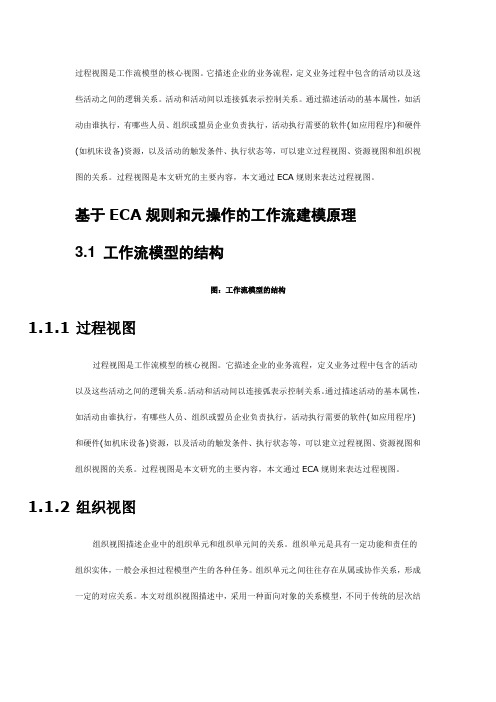
过程视图是工作流模型的核心视图。
它描述企业的业务流程,定义业务过程中包含的活动以及这些活动之间的逻辑关系。
活动和活动间以连接弧表示控制关系。
通过描述活动的基本属性,如活动由谁执行,有哪些人员、组织或盟员企业负责执行,活动执行需要的软件(如应用程序)和硬件(如机床设备)资源,以及活动的触发条件、执行状态等,可以建立过程视图、资源视图和组织视图的关系。
过程视图是本文研究的主要内容,本文通过ECA规则来表达过程视图。
基于ECA规则和元操作的工作流建模原理3.1 工作流模型的结构图:工作流模型的结构1.1.1过程视图过程视图是工作流模型的核心视图。
它描述企业的业务流程,定义业务过程中包含的活动以及这些活动之间的逻辑关系。
活动和活动间以连接弧表示控制关系。
通过描述活动的基本属性,如活动由谁执行,有哪些人员、组织或盟员企业负责执行,活动执行需要的软件(如应用程序)和硬件(如机床设备)资源,以及活动的触发条件、执行状态等,可以建立过程视图、资源视图和组织视图的关系。
过程视图是本文研究的主要内容,本文通过ECA规则来表达过程视图。
1.1.2组织视图组织视图描述企业中的组织单元和组织单元间的关系。
组织单元是具有一定功能和责任的组织实体,一般会承担过程模型产生的各种任务。
组织单元之间往往存在从属或协作关系,形成一定的对应关系。
本文对组织视图描述中,采用一种面向对象的关系模型,不同于传统的层次结构。
是在组织模型中引入类的概念(如角色类、组织类、人员类、职位类等),建立类之间的关系模型,支持层次化的查找和匹配规则,便于工作流的任务分配和执行者绑定。
1.1.3资源视图资源视图描述企业中资源的类型以及资源实体的属性。
资源是工作流模型中非常重要的一个概念,是活动可以执行的必备条件。
资源类型可以是执行活动所需的软件和硬件设施等,或者是活动执行后产生的新的物理实体。
组织视图和资源视图之间存在着映射关系,即每一个资源实体都有与其对应的责任组织单元,该组织单元负责对此资源实体的使用和维护。
工作流模型分析

流程起点模型(四) 多起点模型2
• 起点A 激活工作流后, 导致流程沿着Task A——Task B—— Task C 方向流转。而 从起点B 激活工作流 后,Task A 则被跳过。
终需要重新聚合成一个主流程,以确保流程信息的完整性
(当然,实际运行中,可能存在因为超时等特定原因而最 终抛弃某个子流程)。
•
2)在发散模型中,分支状态是绝对相等的。因发散
而产生的多个分支流程,在最终未必聚合(可能因为种种
原因,聚合的时候会抛弃一个和多个分支流程)
聚合运转模型(一)
同步聚合
• 如图,在And聚合点,会 等待所有分支的到来,如 果不考虑超时(一般流程 回设定任务执行期限)和 异常等情况下,流程必须 等待所有的分支(Task B 和Task C)都执行完(到 达And 汇聚点)后,才能 激活后续的任务,也就说 流程才能正确的往下运行。
流程终止模型
• 按分布分 单结束点 多结束点 非标准结束点:流程结束的地方,不是原先定义的流程节 点。有可能在流程中间因为异常,或人为的强制终止。
• 按行为分 1)正常终止 2)异常终止:非正常因素,系统在运行过程中产生严重 的异常,造成流程非正常终止。一般针对这种可能存在的 情况,流程引擎都会制定一整套处理机制,而且系统监控 模块也需要报告异常的来源和起因。 3)激活新任务:一个流程虽然终止了,但正因为其终止, 而引发其它系统的某些流程或应用实例运行。
工作流模型分析
pjj
文档介绍
一篇关于工作流与obe的通俗文档
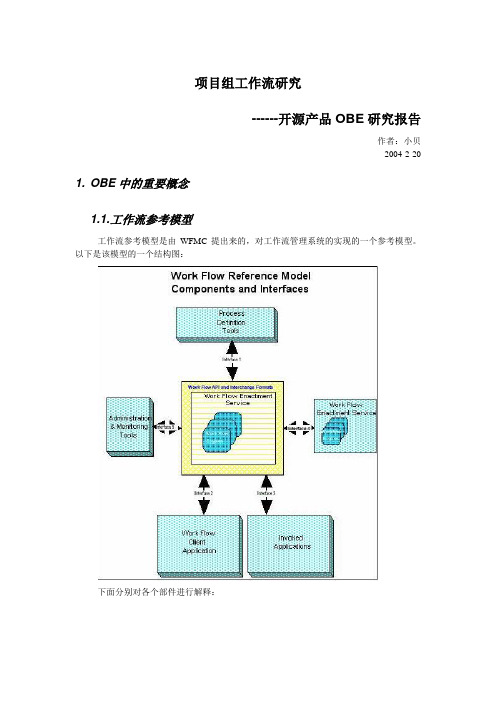
项目组工作流研究------开源产品OBE研究报告作者:小贝2004-2-20 1. OBE中的重要概念1.1. 工作流参考模型工作流参考模型是由WFMC提出来的,对工作流管理系统的实现的一个参考模型。
以下是该模型的一个结构图:下面分别对各个部件进行解释:1.1.1. Work Flow Enactment Service这个组件就是OBE要实现的,主要功能是读取工作流定义、根据定义决定工作流的走向、为客户程序提供接口以驱动工作流。
俗称工作流机或工作流引擎。
1.1.2. Process Definition Tool用于以图形化的方式定义工作流。
目前比较成熟的开源编辑工具为Jawe(),OBE虽然也提供了一个工具,但还没完成。
Process Definition Tool 与Work Flow Enactment Service之间的接口也成为Interface 1,也就是说通过tool生成的文档,Work Flow Enactment Service要可以正确读取。
1.1.3. Work Flow Client Application工作流机的客户端程序。
该程序可为最终用户提供一个定制的用于驱动工作流的接口。
客户端程序通过Interface 2与OBE交互。
这是我们需要开发的。
1.1.4. Invoked Applications在工作流运作的过程中,可能需要调用工作流机之外的功能,这时可通过定义好的Interface 3来完成。
这也是我们需要开发的。
1.1.5. Administration and Monitoring Tools用于管理和监视工作流机。
在OBE中的实现则是OBEWorklist。
1.1.6. 别的Work Flow Enactment ServiceInterface 4用于工作流机之间的协作。
1.2. X PDL对工作流的定义是以XPDL文档的方式存在的。
XPDL是eXtensible Process Definition Language的缩写,且格式为XML的格式。
工作流模式——精选推荐

⼯作流模式1编程模型从消化系统讲起,⼝腔、肠道、胃…等消化器官组成了消化系统,每个器官⼜是由更微观的物质构成,⽐如细胞。
细胞⼜可以细分。
细胞可以分类,⽩细胞,红细胞等等。
这⾥细胞可以认为是消化系统的基本组成元素。
这种组成结构⾮常像⾯向对象的思维,因为它们都要解决同⼀个问题:现实世界复杂性。
类可以认为是最基本的组成元素,类可以组成组件(构件),构件组成服务。
知道了消化系统的组成,我们来看如何实现吃这个功能,吃的功能完成需要⾷物通过各种消化器官,使⽤消化器官的功能完成。
这个过程是⾯向过程的,是⼀个流程。
再看我们程序的实现,Staitc Main是程序的⼊⼝,C#中功能的实现也是通过调⽤相互关联的类中的⽅法实现的。
C#本⾝就提供了丰富的控制结构(if else,while等等)。
分析:从最简单的语句到类到组件,到⼦系统。
代码结构的最优化组织⽅式采⽤⾯向对象,可以更好复⽤,使⽤设计模式后可以更好控制变化。
但是运⾏时逻辑往往是⾯向过程的。
⽐如Main{}中的逻辑。
就象细胞构成嘴、肠胃,这些器官⼜构成了消化系统,但是吃饭这个功能的完成是利⽤各个器官的功能,按照某种控制流程完成的。
结论:程序的⽬标之⼀是功能实现,其中实现⽅式是基于过程的,组织结构是⾯向对象的。
1.1过程控制模型常见的过程控制模型有:1、C#语句控制流;2、XAML;3、数据库表;4、DSL(领域描述语⾔),图形(专⽤的图形⼯具)。
数据库表中可以存储过程的调度逻辑,领域模式语⾔这⼏年也⾮常流⾏。
过程的描述可以⽤任何⼀种⽅法实现。
1.2C#控制流程的问题看⼀看交互式过程:在流转的过程中需要外部消息的响应的过程。
可能某个处理会等待⼏天甚⾄⼏周。
如果使⽤C#控制流实现,应该怎么实现。
⼀般的做法是新建⼀个线程异布执⾏某个流程,⽽主线程持续运⾏(类似Windows服务),如果流程停滞,线程会被阻塞,如果阻塞的线程⼀多,整个系统的性能就会有很⼤影响,毕竟线程池等系统资源有限。
工作流管理系统参考模型
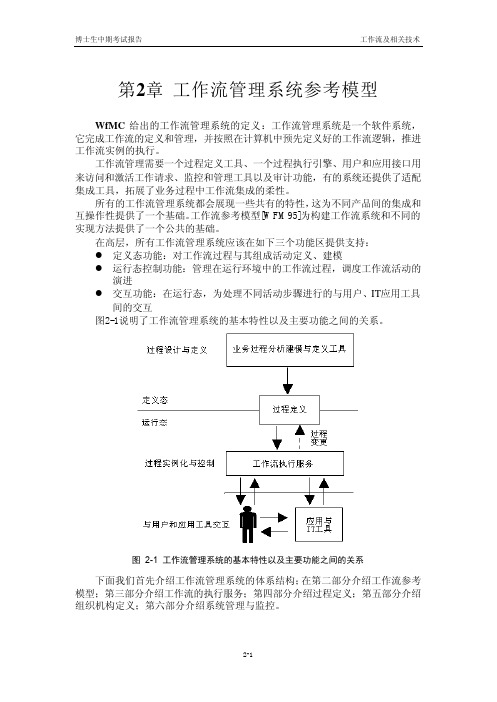
第2章工作流管理系统参考模型WfMC给出的工作流管理系统的定义:工作流管理系统是一个软件系统,它完成工作流的定义和管理,并按照在计算机中预先定义好的工作流逻辑,推进工作流实例的执行。
工作流管理需要一个过程定义工具、一个过程执行引擎、用户和应用接口用来访问和激活工作请求、监控和管理工具以及审计功能,有的系统还提供了适配集成工具,拓展了业务过程中工作流集成的柔性。
所有的工作流管理系统都会展现一些共有的特性,这为不同产品间的集成和互操作性提供了一个基础。
工作流参考模型[WFM95]为构建工作流系统和不同的实现方法提供了一个公共的基础。
在高层,所有工作流管理系统应该在如下三个功能区提供支持:l 定义态功能:对工作流过程与其组成活动定义、建模l 运行态控制功能:管理在运行环境中的工作流过程,调度工作流活动的演进l 交互功能:在运行态,为处理不同活动步骤进行的与用户、IT应用工具间的交互图2-1说明了工作流管理系统的基本特性以及主要功能之间的关系。
图2-1 工作流管理系统的基本特性以及主要功能之间的关系下面我们首先介绍工作流管理系统的体系结构;在第二部分介绍工作流参考模型;第三部分介绍工作流的执行服务;第四部分介绍过程定义;第五部分介绍组织机构定义;第六部分介绍系统管理与监控。
2.1 工作流管理系统的体系结构为了能够更好地支持企业业务过程建模、分析和实施,适应世界市场的多元化趋势,需要建立工作流管理系统的相关标准,从系统结构、术语使用、接口实施方面提供标准化与规范化的定义,并以此为基础实现不同工作流产品之间的互操作,便于与其他应用系统的集成。
在建立工作流的相关规范和标准方面,国际上成立了一个称为“工作流管理联盟”(简称WfMC)的国际组织。
它提出了有关工作流管理系统的一些规范,定义了工作流管理系统的结构及其与应用、管理工具和其他工作流管理系统之间的应用编程接口,其主要目的是为了实现工作流技术的标准化和开放性,从而支持异构工作流管理系统与产品之间的互操作,并且使得其他的应用可以使用该结构和定义好的通用API(应用编程接口)访问不同的工作流管理系统提供的服务,实现与其他应用的快速有效集成。
工作流引擎标准
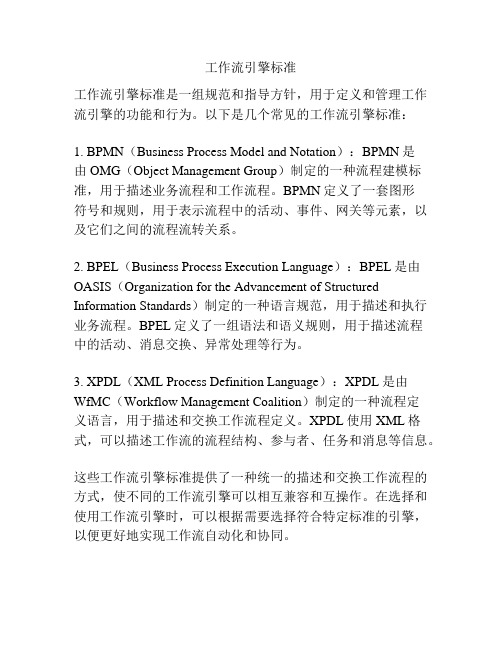
工作流引擎标准
工作流引擎标准是一组规范和指导方针,用于定义和管理工作流引擎的功能和行为。
以下是几个常见的工作流引擎标准:
1. BPMN(Business Process Model and Notation):BPMN是
由OMG(Object Management Group)制定的一种流程建模标准,用于描述业务流程和工作流程。
BPMN定义了一套图形
符号和规则,用于表示流程中的活动、事件、网关等元素,以及它们之间的流程流转关系。
2. BPEL(Business Process Execution Language):BPEL是由OASIS(Organization for the Advancement of Structured Information Standards)制定的一种语言规范,用于描述和执行业务流程。
BPEL定义了一组语法和语义规则,用于描述流程
中的活动、消息交换、异常处理等行为。
3. XPDL(XML Process Definition Language):XPDL是由WfMC(Workflow Management Coalition)制定的一种流程定
义语言,用于描述和交换工作流程定义。
XPDL使用XML格式,可以描述工作流的流程结构、参与者、任务和消息等信息。
这些工作流引擎标准提供了一种统一的描述和交换工作流程的方式,使不同的工作流引擎可以相互兼容和互操作。
在选择和使用工作流引擎时,可以根据需要选择符合特定标准的引擎,以便更好地实现工作流自动化和协同。
WFMC-TC-1003-工作流参考模型(ch)
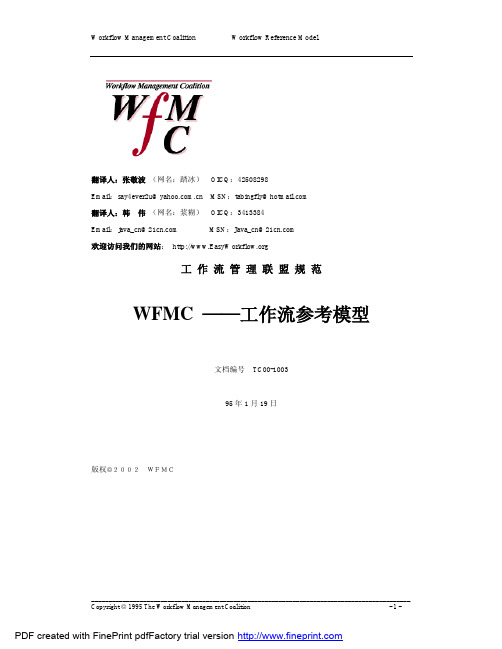
翻译人:张敬波(网名:踏冰)OICQ:42508298Email:say4ever2u@ MSN:tabingfly@翻译人:韩伟(网名:浆糊)OICQ:3413384Email:java_cn@ MSN:Java_cn@欢迎访问我们的网站:工作流管理联盟规范WFMC ——工作流参考模型文档编号TC00-100395年1月19日版权©2002WFMC目录目录...................................................................................................................................- 2 -1.简介...............................................................................................................................................- 4 -1.1. 背景.....................................................................................................................................- 4 -1.2. 目的.....................................................................................................................................- 4 -1.3. 范围.....................................................................................................................................- 4 -1.4. 对象.....................................................................................................................................- 5 -1.5. 如何阅读.............................................................................................................................- 5 -1.6. 参考.....................................................................................................................................- 5 -1.7. 修订历史.............................................................................................................................- 5 -2.工作流系统简介...........................................................................................................................- 6 -2.1. 什么是工作流(workflow)..............................................................................................- 6 -2.1.1. 建立时期功能..........................................................................................................- 7 -2.1.2. 运行时期过程控制功能...........................................................................................- 8 -2.1.3. 运行时期活动交互..................................................................................................- 8 -2.1.4. 分配与系统接口......................................................................................................- 8 -2.2. 工作流的发展.....................................................................................................................- 9 -2.3. 产品实现模型.....................................................................................................................- 9 -2.4. 可选择的实现方式(Alternative Implementation Scenarios).......................................- 14 -2.5. 对标准化的需要(The Need for Standardization)........................................................- 17 -3.工作流参考模型(Workflow Reference Model).....................................................................- 18 -3.1. 简介...................................................................................................................................- 18 -3.2. 工作流模型(The Workflow Model)............................................................................- 18 -3.3. 工作流执行服务器(Workflow Enactment Services)...................................................- 19 -3.3.1. 什么是工作流执行服务器?.................................................................................- 19 -3.3.2. 工作流机(The Workflow Engine).....................................................................- 20 -3.3.3. 同种和异种的工作流执行服务器(Homogeneous & Heterogeneous WorkflowEnactment Services)........................................................................................................- 21 -3.3.4. 工作流应用编程接口与数据交换(Workflow Application programming Interface &Interchange)....................................................................................................................- 23 -3.3.5. 工作流控制,工作流相关数据和工作流应用数据.............................................- 23 -3.3.6. 数据交换(Data Interchange).............................................................................- 24 -3.4. 过程定义(Process Definition)......................................................................................- 25 -3.4.1. 过程定义工具(Process Definition Tools).........................................................- 25 -3.4.2. 工作流定义转换(接口1)..................................................................................- 26 -3.5. 工作流客户端功能(Workflow Client Functions)........................................................- 29 -3.5.1. 工作流客户端应用程序(Workflow Client Applications)................................- 29 -3.5.2. 工作流客户端应用程序接口(接口2)..............................................................- 30 -3.6. 应用程序调用功能(Invoked Application Functions)..................................................- 32 -3.6.1. 应用程序调用(Invoked Applications)..............................................................- 32 -3.6.2. 应用程序调用接口(接口3)..............................................................................- 33 -3.7. 工作流协同工作流能力(Workflow Interoperability).................................................- 35 -3.7.1. 异种工作流执行服务器.........................................................................................- 35 -3.7.2 模型1 ——链锁式(Chained).........................................................................- 35 -3.7.3. 模型2 ——子过程嵌套(Nested Subprocesses)............................................- 36 -3.7.4. 模型3 —— P2P (Peer-to-Peer).......................................................................- 37 -3.7.5. 模型4 ——相似同步(Parallel Synchronised)...............................................- 38 -3.7.6. WAPI协调工作功能(接口4)...........................................................................- 38 -3.8. 系统管理(Systems Administration).............................................................................- 41 -3.8.1 管理和监视工具(Administration & Monitoring Tools)....................................- 41 -3.8.2. 管理和监视接口(接口5)..................................................................................- 41 -4. WAPI 结构、协议和一致性.......................................................................................................- 44 -4.1. WAPI——API功能简介...................................................................................................- 44 -4.2. WAPI协议.........................................................................................................................- 45 -4.3. 一直性原则.......................................................................................................................- 45 -4.3.1. 一致性的意义........................................................................................................- 46 -4.4. 协同工作能力分类和一致性级别....................................................................................- 46 -4.4.1 定义工具、工作流执行软件..................................................................................- 46 -4.4.2 可户端应用程与工作流执行服务器序协同工作..................................................- 46 -4.4.3. 应用程序和工具集成............................................................................................- 47 -4.4.4. 工作流执行服务器协同工作.................................................................................- 47 -4.4.5. 公共工作流管理....................................................................................................- 47 -1.简介1.1. 背景工作流管理系统一项快速发展的技术,各种行业渐渐的采用工作流技术。
工作流参考模型英文
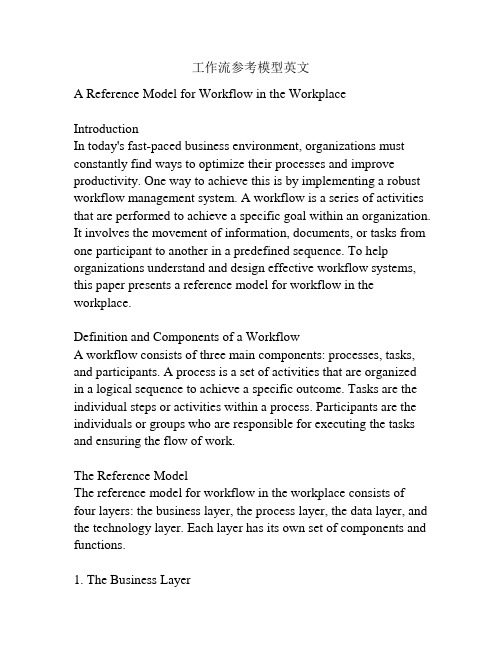
工作流参考模型英文A Reference Model for Workflow in the WorkplaceIntroductionIn today's fast-paced business environment, organizations must constantly find ways to optimize their processes and improve productivity. One way to achieve this is by implementing a robust workflow management system. A workflow is a series of activities that are performed to achieve a specific goal within an organization. It involves the movement of information, documents, or tasks from one participant to another in a predefined sequence. To help organizations understand and design effective workflow systems, this paper presents a reference model for workflow in the workplace.Definition and Components of a WorkflowA workflow consists of three main components: processes, tasks, and participants. A process is a set of activities that are organizedin a logical sequence to achieve a specific outcome. Tasks are the individual steps or activities within a process. Participants are the individuals or groups who are responsible for executing the tasks and ensuring the flow of work.The Reference ModelThe reference model for workflow in the workplace consists of four layers: the business layer, the process layer, the data layer, and the technology layer. Each layer has its own set of components and functions.1. The Business LayerThe business layer represents the overall goals and objectives of the organization. It includes components such as the organizational structure, business rules, and performance metrics. The business layer defines the context in which the workflow operates and provides a framework for aligning the workflow with the strategic goals of the organization.2. The Process LayerThe process layer defines the set of activities that need to be performed to accomplish a specific task or goal. It includes components such as process models, process definitions, and process analysis tools. The process layer provides a structured framework for organizing and managing the activities within a workflow.3. The Data LayerThe data layer represents the information that is generated, processed, and stored during the workflow. It includes components such as data models, data integration tools, and data validation mechanisms. The data layer ensures that the right information is available at the right time to support decision making and enable efficient workflow execution.4. The Technology LayerThe technology layer includes the tools and systems that are used to implement and execute the workflow. It includes components such as workflow management systems, document management systems, and collaboration tools. The technology layer provides the necessary infrastructure for automating and optimizing the workflow processes.Benefits of the Reference ModelBy using the reference model for workflow in the workplace, organizations can achieve several benefits:1. Improved Efficiency: The reference model helps streamline processes, eliminate redundancies, and minimize errors, resulting in improved efficiency and productivity.2. Enhanced Collaboration: The model facilitates effective communication and collaboration among participants, leading to better coordination and teamwork.3. Better Decision Making: The model provides real-time access to accurate and up-to-date information, enabling participants to make informed decisions quickly.4. Increased Transparency: The model promotes transparency by providing visibility into the workflow processes and progress, making it easier to identify bottlenecks and areas for improvement.5. Continuous Improvement: The model encourages organizations to regularly analyze and optimize their workflows, leading to a continuous improvement cycle that drives innovation and competitiveness.ConclusionA well-designed and efficient workflow is essential for organizations to stay competitive in today's dynamic business landscape. The reference model presented in this paper provides acomprehensive framework for understanding and implementing workflow in the workplace. By utilizing this model, organizations can optimize their processes, improve productivity, and achieve their strategic goals.Sure! Here are some additional points to further expand on the topic:6. Scalability: The reference model allows organizations to scale their workflows as their business grows. By designing processes that can accommodate higher volumes of tasks and participants, organizations can maintain efficiency and productivity even as they expand.7. Flexibility: The model provides flexibility in designing workflows to fit the specific needs of different departments or teams within an organization. By customizing processes and tasks based on the requirements of specific roles or projects, organizations can maximize effectiveness and adaptability.8. Compliance and Auditability: The reference model helps organizations ensure compliance with industry regulations and internal policies. By incorporating security measures, access controls, and audit trails, organizations can track and document workflow activities, demonstrating transparency and accountability.9. Integration with External Systems: The technology layer of the reference model enables seamless integration with external systems, such as customer relationship management (CRM) or enterprise resource planning (ERP) systems. Integrating workflows with these systems ensures efficient data exchange and eliminates manual data entry, reducing errors and improving overallproductivity.10. Mobile Accessibility: With the proliferation of mobile devices, it is crucial for workflows to be accessible anytime and anywhere. The reference model supports mobile access, allowing participants to view tasks, provide approvals, and receive notifications on their smartphones or tablets. This enhances productivity by enabling participants to stay connected and make decisions on the go.11. Analytics and Reporting: The data layer of the reference model enables organizations to collect and analyze workflow data, providing valuable insights for process improvement. By generating reports and visualizations, organizations can identify bottlenecks, monitor performance metrics, and make data-driven decisions to optimize workflows.12. Change Management: Implementing a new workflow system requires change management efforts to ensure a smooth transition. The reference model allows organizations to plan and execute change management strategies, involving stakeholders and providing training to ensure successful adoption and utilization of the workflow system.13. Continuous Training and Support: The technology layer of the reference model requires ongoing training and support to ensure participants understand and effectively use the workflow tools and systems. Organizations should provide comprehensive training programs, user manuals, and continuous support to help participants navigate the workflow processes and overcome any challenges.14. Integration of Artificial Intelligence and Automation: As technology advances, organizations can leverage artificial intelligence (AI) and automation to further optimize workflows.By incorporating AI algorithms and automation tools, organizations can automate repetitive tasks, make intelligent predictions, and enhance decision-making processes within workflows.15. Security and Data Privacy: Organizations must prioritize security and data privacy when designing and implementing workflow systems. The reference model emphasizes the need for robust security measures, including encryption, access controls, and data encryption, to protect sensitive information and ensure compliance with data protection regulations.In conclusion, the reference model for workflow in the workplace provides organizations with a comprehensive framework to optimize processes, improve productivity, and achieve their strategic goals. By implementing efficient workflows that align with organizational objectives, organizations can enhance collaboration, make better decisions, and continuously improve their workflows. With the right technology and support, organizations can leverage this reference model to drive innovation, competitiveness, and success in today's rapidly evolving business landscape.。
工作流参考模型
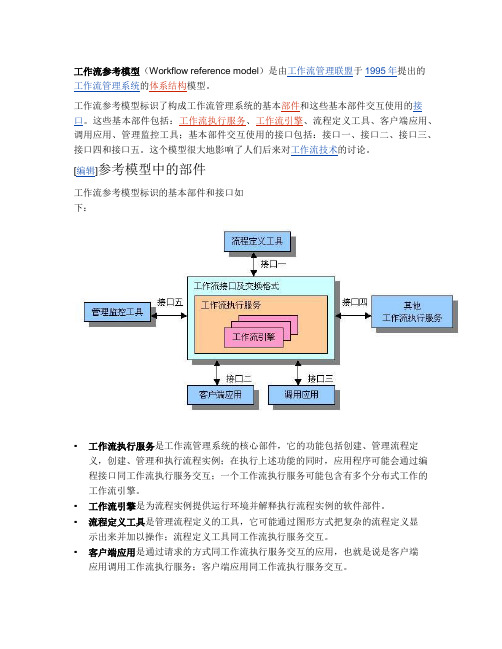
工作流参考模型(Workflow reference model)是由工作流管理联盟于1995年提出的工作流管理系统的体系结构模型。
工作流参考模型标识了构成工作流管理系统的基本部件和这些基本部件交互使用的接口。
这些基本部件包括:工作流执行服务、工作流引擎、流程定义工具、客户端应用、调用应用、管理监控工具;基本部件交互使用的接口包括:接口一、接口二、接口三、接口四和接口五。
这个模型很大地影响了人们后来对工作流技术的讨论。
[编辑]参考模型中的部件工作流参考模型标识的基本部件和接口如下:▪工作流执行服务是工作流管理系统的核心部件,它的功能包括创建、管理流程定义,创建、管理和执行流程实例;在执行上述功能的同时,应用程序可能会通过编程接口同工作流执行服务交互;一个工作流执行服务可能包含有多个分布式工作的工作流引擎。
▪工作流引擎是为流程实例提供运行环境并解释执行流程实例的软件部件。
▪流程定义工具是管理流程定义的工具,它可能通过图形方式把复杂的流程定义显示出来并加以操作;流程定义工具同工作流执行服务交互。
▪客户端应用是通过请求的方式同工作流执行服务交互的应用,也就是说是客户端应用调用工作流执行服务;客户端应用同工作流执行服务交互。
▪调用应用是被工作流执行服务调用的应用;调用应用同工作流执行服务交互。
为了协作完成一个流程实例的执行,不同的工作流执行服务之间进行交互。
▪管理监控工具主要指组织机构、角色等数据的维护管理和流程执行情况的监控;管理监控工具同工作流执行服务交互。
[编辑]参考模型中的接口▪接口一(工作流定义交换),用于在建模和定义工具与执行服务之间交换工作流定义。
主要是数据交换格式和API。
数据交换通过XPDL,API通过WAPI。
▪接口二(工作流客户端应用接口),用于工作流客户端应用访问工作流引擎和工作列表,通过WAPI完成。
▪接口三(被调用的应用接口)用于调用不同的应用系统。
▪接口四(工作流系统互操作接口),用于不同工作流系统之间的互操作。
工作流
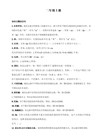
? SequenceActivity
一个能够允许我们添加多个顺序执行的自活动的复合活动。可以看做是WPF中的“容器”,有些只能接受一个子活动的活动比如ReplicatorActivity、WhileActivity和ParallelActivity,可以用这种方法来添加“多个”子活动。
序列式工作流将一系列待执行的步骤以一种预先描述好的次序描述出来。在这种工作流里,控制流程的是我们很熟悉的诸如if-else和while循环结构。这个工作流有着确定的起点与终点,我们不能随意跳转到中间的某个点上,唯一能做的只有从头开始。
状态机工作流则并不定义固定的流程,它们定义一组状态,包括状态之间可能存在的转移。每个状态可以转移到一个或多个其它状态上去。执行这样的工作流不一定要从第一个状态开始。这就允许工作流被打断,然后根据需要恢复。在WF中,状态的转移是通过宿主应用程序引起的外部事件触发的,这就意味着工作流的控制完全是交由外界完成的。
工作流(workflow)是为了完成一些预定的目的,根据一组规则,而制定的一系列步骤。对于一个开发者来说,workflow则是将复杂的业务规则以及控制流程以图形化的方法声明出来,组成一个高度可视化的图形环境。
一、工作流分类
在WF中,工作流分为两种类型,序列式(Sequential)和状态机(State Machine)。
? StateFinalizationActivity
与上面那个活动相反,它定义的是离开某个状态之前需要执行的业务。
? Event Handling
这一类活动与事件句柄相关,并且需要与接收这些事件的子活动一起工作。这里提到的活动本身并不实际接收这些事件,它们只是另一些事件驱动(event-driven)活动的容器。下面提到的活动解释都比较复杂,我暂时也搞不清楚,在这里仅仅列出名称,详情还请参阅MSDN。
工作流参考模型(WFMC)
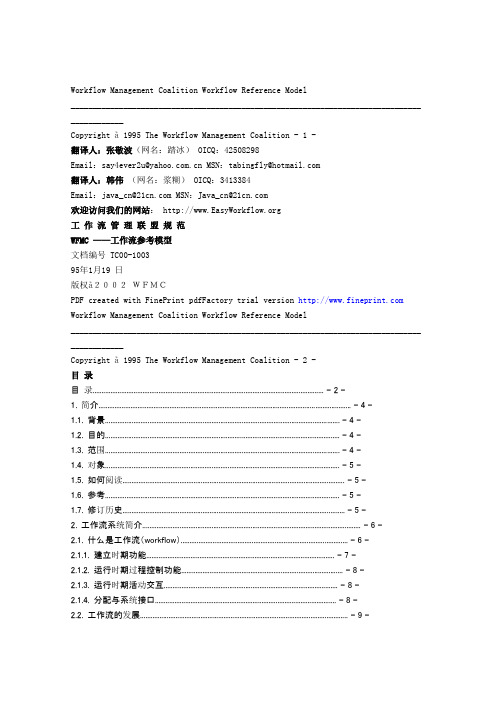
Workflow Management Coalition Workflow Reference Model________________________________________________________________________________ ____________Copyright ã 1995 The Workflow Management Coalition - 1 -翻译人:张敬波(网名:踏冰) OICQ:42508298Email:say4ever2u@ MSN:tabingfly@翻译人:韩伟(网名:浆糊) OICQ:3413384Email:java_cn@ MSN:Java_cn@欢迎访问我们的网站: 工作流管理联盟规范WFMC ——工作流参考模型文档编号 TC00-100395年1月19 日版权ã2002WFMCPDF created with FinePrint pdfFactory trial version Workflow Management Coalition Workflow Reference Model________________________________________________________________________________ ____________Copyright ã 1995 The Workflow Management Coalition - 2 -目录目录.................................................................................................................................. - 2 -1.简介.............................................................................................................................................. - 4 -1.1. 背景.................................................................................................................................... - 4 -1.2. 目的.................................................................................................................................... - 4 -1.3. 范围.................................................................................................................................... - 4 -1.4. 对象.................................................................................................................................... - 5 -1.5. 如何阅读............................................................................................................................. - 5 -1.6. 参考.................................................................................................................................... - 5 -1.7. 修订历史............................................................................................................................. - 5 -2.工作流系统简介........................................................................................................................... - 6 -2.1. 什么是工作流(workflow).............................................................................................. - 6 -2.1.1. 建立时期功能.......................................................................................................... - 7 -2.1.2. 运行时期过程控制功能........................................................................................... - 8 -2.1.3. 运行时期活动交互.................................................................................................. - 8 -2.1.4. 分配与系统接口...................................................................................................... - 8 -2.2. 工作流的发展..................................................................................................................... - 9 -2.3. 产品实现模型..................................................................................................................... - 9 -2.4. 可选择的实现方式(Alternative Implementation Scenarios)....................................... - 14 - 2.5. 对标准化的需要(The Need for Standardization)........................................................ - 17 - 3.工作流参考模型(Workflow Reference Model)..................................................................... - 18 -3.1. 简介.................................................................................................................................. - 18 -3.2. 工作流模型(The Workflow Model)............................................................................ - 18 -3.3. 工作流执行服务器(Workflow Enactment Services)................................................... - 19 - 3.3.1. 什么是工作流执行服务器?................................................................................. - 19 -3.3.2. 工作流机(The Workflow Engine)..................................................................... - 20 -3.3.3. 同种和异种的工作流执行服务器(Homogeneous & Heterogeneous Workflow Enactment Services)........................................................................................................ - 21 -3.3.4. 工作流应用编程接口与数据交换(Workflow Application programming Interface & Interchange)................................................................................................................... - 23 -PDF created with FinePrint pdfFactory trial version Workflow Management Coalition Workflow Reference Model____________________________________________________________________________________________Copyright ã 1995 The Workflow Management Coalition - 3 -3.3.5. 工作流控制,工作流相关数据和工作流应用数据............................................. - 23 -3.3.6. 数据交换(Data Interchange)............................................................................. - 24 -3.4. 过程定义(Process Definition)...................................................................................... - 25 -3.4.1. 过程定义工具(Process Definition Tools)......................................................... - 25 -3.4.2. 工作流定义转换(接口1).................................................................................. - 26 -3.5. 工作流客户端功能(Workflow Client Functions)........................................................ - 29 - 3.5.1. 工作流客户端应用程序(Workflow Client Applications)................................ - 29 -3.5.2. 工作流客户端应用程序接口(接口2).............................................................. - 30 -3.6. 应用程序调用功能(Invoked Application Functions).................................................. - 32 - 3.6.1. 应用程序调用(Invoked Applications).............................................................. - 32 -3.6.2. 应用程序调用接口(接口3).............................................................................. - 33 -3.7. 工作流协同工作流能力(Workflow Interoperability)................................................. - 35 - 3.7.1. 异种工作流执行服务器......................................................................................... - 35 -3.7.2 模型1 ——链锁式(Chained)......................................................................... - 35 -3.7.3. 模型2 ——子过程嵌套(Nested Subprocesses)............................................ - 36 -3.7.4. 模型3 ——P2P (Peer-to-Peer)....................................................................... - 37 -3.7.5. 模型 4 ——相似同步(Parallel Synchronised)............................................... - 38 -3.7.6. WAPI 协调工作功能(接口4)........................................................................... - 38 -3.8. 系统管理(Systems Administration)............................................................................. - 41 -3.8.1 管理和监视工具(Administration & Monitoring Tools).................................... - 41 -3.8.2. 管理和监视接口(接口5).................................................................................. - 41 -4. WAPI 结构、协议和一致性....................................................................................................... - 44 -4.1. WAPI——API功能简介................................................................................................... - 44 -4.2. WAPI协议......................................................................................................................... - 45 -4.3. 一直性原则....................................................................................................................... - 45 -4.3.1. 一致性的意义........................................................................................................ - 46 -4.4. 协同工作能力分类和一致性级别.................................................................................... - 46 -4.4.1 定义工具、工作流执行软件.................................................................................. - 46 -4.4.2 可户端应用程与工作流执行服务器序协同工作.................................................. - 46 -4.4.3. 应用程序和工具集成............................................................................................ - 47 -4.4.4. 工作流执行服务器协同工作................................................................................. - 47 -4.4.5. 公共工作流管理.................................................................................................... - 47 -PDF created with FinePrint pdfFactory trial version Workflow Management Coalition Workflow Reference Model________________________________________________________________________________ ____________Copyright ã 1995 The Workflow Management Coalition - 4 -1.简介1.1. 背景工作流管理系统一项快速发展的技术,各种行业渐渐的采用工作流技术。
工作流模型

一:数据模型E_R图说明:1.1信息模型信息模型的核心是业务活动表(简称活动)ACTIVITY,其他相关的表结构主要有业务过程PROCESS、业务规则(活动流转规则)ROUTING_RULE、活动前依赖规则PRE_RULE、任务指派规则ASSGN_RULE、任务列表TO_DO_TASK_LIST以及已完成的任务列表HAVE_DONE_TASKS。
从图中可以看出,ACTIVITY与其他表之间都存在联系。
1.1.1活动类型每个业务过程由若干业务活动组成,不同的业务活动通过各不相同的ACT_ID来唯一标识,ACT_TYPE则指明相应活动的类型。
同一个业务活动在工作流运行时可能具有多个实例(instance)。
我们将活动的实例称为任务1,将属于同一业务过程的任务称为属于同一批次的任务。
有的业务活动可能针对具体的业务环节,即在前台(后台)对应实际的应用逻辑;有的业务活动则不针对具体的业务环节。
活动类型可以进行如下分类:●INITIAL,初始化活动,业务过程的第一个活动,不针对具体业务环节。
●INTERACTION,常规交互活动,INTERACTION活动对应实际的业务环节,在前台对应实际的应用逻辑,完成此活动需要实际人员的参与。
在所有活动类型中,只有INTERACTION活动才需要与实际人员交互。
●AUTOMATION,常规自动活动,同样对应实际的业务环节,但是实际的应用逻辑位于后台,由工作流引擎自动调用完成。
AUTO_EXECUTIVE指明相应应用逻辑的执行体。
●AND_BRANCH,与分支活动,不针对具体业务环节,此活动将同时派生出若干后继活动。
●AND_MERGE,与汇聚活动,是一同步活动,不针对具体业务环节,流经此处的任务将进行与汇聚同步。
此活动将进行活动的前依赖规则检查,只有所有的前依赖规则均被满足,才可流向后继活动。
●OR_MERGE,或汇聚活动,是一同步活动,不针对具体业务环节,流经此处的任务将进行或汇聚同步。
工作流概念介绍-课件(1)
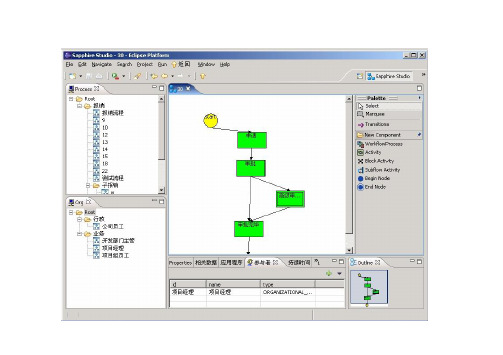
Workflow Reference Model
Workflow Reference Model
2004年,大卫·霍林斯沃思在回顾工作流参考模型 十年的历程时指出:工作流参考模型的引入为人们讨论 工作流技术提供了一个规范的术语表,为在一般意义上 讨论工作流系统的体系结构提供了基础;工作流参考模 型为工作流管理系统的关键模块提供了功能描述,并描 述了关键模块之间的交互,而且这个描述是独立于特定 产品或技术的实现的;从功能的角度定义五个关键模块 的交互接口,推动了信息交换的标准化,使得不同产品 间的互操作成为可能。
上海敏节 北京麒麟远创
北京有生博大 北京东方易维 北京美髯公 用友政务 上海泛微 北京点击科技 用友NC审批流
思维加速 普元EOS 科诺KA-2 用友工程GAP
Why use开源
Workflow Technology
把计算机技术在工作流程管理中的应用称为工作流技术。当然, 应用工作流技术所体现的形式是一个工作流平台或工作流管理系统。 而不是hardcode的应用。
• 逻辑和行为上的分层 • 业务人员更加清楚地把握业务 • 实施人员更容易开发 • 管理人员更容易控制和管理业务 • 支持业务过程的重组和优化
最基本工作流系统
• Design • Execution • Admin/Monitor
Execution <--- Engine
Common Enterprise Workflow
David Hollingsworth: The Workflow Reference Model: 10 Years On; Workflow Handbook 2004
工作任务模型英语
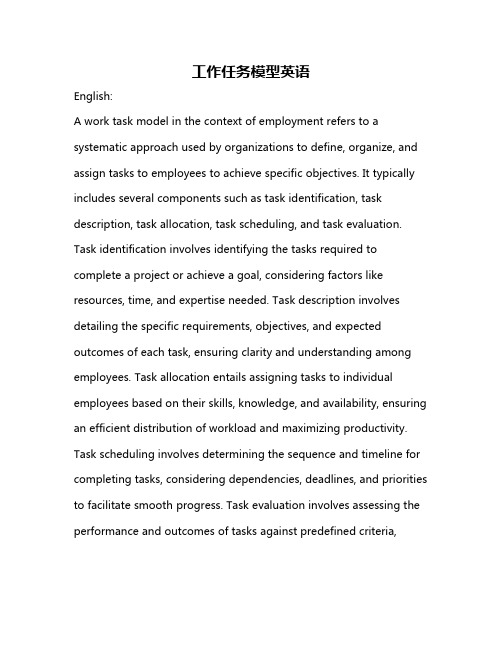
工作任务模型英语English:A work task model in the context of employment refers to a systematic approach used by organizations to define, organize, and assign tasks to employees to achieve specific objectives. It typically includes several components such as task identification, task description, task allocation, task scheduling, and task evaluation. Task identification involves identifying the tasks required to complete a project or achieve a goal, considering factors like resources, time, and expertise needed. Task description involves detailing the specific requirements, objectives, and expected outcomes of each task, ensuring clarity and understanding among employees. Task allocation entails assigning tasks to individual employees based on their skills, knowledge, and availability, ensuring an efficient distribution of workload and maximizing productivity. Task scheduling involves determining the sequence and timeline for completing tasks, considering dependencies, deadlines, and priorities to facilitate smooth progress. Task evaluation involves assessing the performance and outcomes of tasks against predefined criteria,providing feedback for improvement and ensuring alignment with organizational goals and standards.中文翻译:在就业背景下,工作任务模型是组织机构用来定义、组织和分配任务给员工以实现特定目标的系统化方法。
工作流建模工具
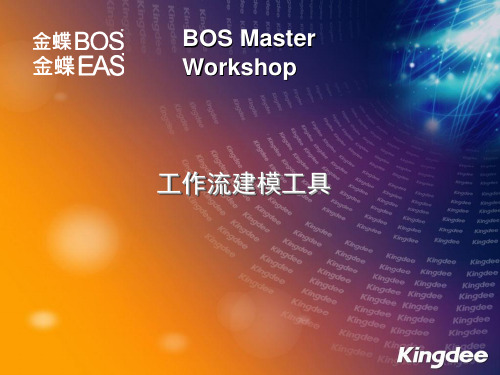
P39
工作流新增特性
完善消息 使用说明, 增加了邮 件发送功 能
P40
工作流新增特性
增加短信 发送功能
P41
谢 谢!
P42
P16
采购申请流程变量说明
billID,变量类型为内码(BOID)类型,由于关联 流程各个节点 Audit,枚举变量,用于部门经理审批意见 Money,采购申请单申请金额 Audit1,枚举变量,总经理审批意见
P17
其他节点:任务定义
业务单据内码 审批结果输出到 枚举变量
P18
消息定义
对于启动流程的节点,一般不需要消息 任务消息可以引用变量,格式:@@ + 变 量名 例如:请请审批@@billID采购申请单,金 额@@money
P7
流程属性界面
P8
节点类型说明
节点 开始节点 结束节点 人工型节点 自动应用节点 子流程节点
路由节点(空节点)
审批节点 决策节点 等待节点 消息节点 单据转换节点 函数节点 脚本节点
P9
节点
流程有且只有一个开始节点,流程可以有 多个结束节点 开始节点只能流出,结束节点只能流入 开始节点连接的第一个节点为启动节点
P30
流程多语言定义
可以定义多语言的内容:
流程名称 流程备注 活动名称 活动备注 任务消息
P31
工作流新增特性
上下级流程审批是否同一个人的判断:
在多极审批的审批处理界面 , 当建模工具的流程配置中流程上下 级审批节点直接相连,并且参与人是同一个人时.在上级审批的 处理界面中,审批通过后,下级审批会自动以审批通过的方式通 过,进入下一个节点。
BOS Master Workshop
工作流建模工具
- 1、下载文档前请自行甄别文档内容的完整性,平台不提供额外的编辑、内容补充、找答案等附加服务。
- 2、"仅部分预览"的文档,不可在线预览部分如存在完整性等问题,可反馈申请退款(可完整预览的文档不适用该条件!)。
- 3、如文档侵犯您的权益,请联系客服反馈,我们会尽快为您处理(人工客服工作时间:9:00-18:30)。
SECTION 1SCM TEMPLATE WORKFLOW©2000 i2 Technologies, Inc. -2-SCM Template WorkflowRelease 4.2.1Copyright 2000 i2 Technologies, Inc.This notice is intended as a precaution against inadvertent publication and does not imply any waiverof confidentiality. Information in this document is subject to change without notice. No part of thisdocument may be reproduced or transmitted in any form or by any means, electronic or mechanical,including photocopying, recording, or information storage or retrieval systems, for any purposewithout the express written permission of i2 Technologies, Inc.The software and/or database described in this document are furnished under a license agreement ornondisclosure agreement. It is against the law to copy the software on any medium except asspecifically allowed in the license or nondisclosure agreement. If software or documentation is tobe used by the federal government, the following statement is applicable:In accordance withFAR 52.227-19 Commercial Computer Software —Restricted Rights, the following applies:This software is Unpublished—rights reserved under the copyright laws of the United States.The text and drawings set forth in this document are the exclusive property of i2 Technologies, Inc.Unless otherwise noted, all names of companies, products, street addresses, and persons contained inthe scenarios are designed solely to document the use of i2 Technologies, Inc. products.The brand names and product names used in this manual are the trademarks, registered trademarks,service marks or trade names of their respective owners. i2 Technologies, Inc. is not associatedwith any product or vendor mentioned in this publication unless otherwise noted.The following trademarks and service marks are the property of i2 Technologies, Inc.: EDGE OFINSTABILITY; i2 TECHNOLOGIES; ORB NETWORK; PLANET; and RESULTS DRIVENMETHODOLOGY.The following registered trademarks are the property of i2 Technologies, Inc.: GLOBAL SUPPLYCHAIN MANAGEMENT; i2; i2 TECHNOLOGIES and design; TRADEMATRIX;TRADEMATRIX and design; and RhythmLink.February, 2000©2000 i2 Technologies, Inc. -3-SCP Master Planning Technical Implementer Reference Manual ContentsSCM PROCESSES OVERVIEWSCM P ROCESSESDEMAND PLANNINGD EMAND F ORECASTINGTop-Down ForecastingBottom-Up ForecastingLife Cycle Planning – New Product Introductions and Phase-In/Phase-OutEvent PlanningConsensus ForecastAttach-Rate Forecasting/Dependent Demand Forecasting in Configure-to-Order environmentsD EMAND C OLLABORATIONFlex Limit PlanningF ORECAST N ETTINGForecast ExtractionMASTER PLANNINGS UPPLY P LANNINGEnterprise Planning: Inventory PlanningEnterprise planning: Long term capacity planningEnterprise planning: Long term material planningFacility Planning: Supply plan for enterprise managed componentsCollaboration Planning for Enterprise and Factory Managed Components – ProcurementCollaborationCollaboration Planning with Transportation Providers - Transportation CollaborationA LLOCATION P LANNINGDEMAND FULFILLMENTO RDER P ROMISINGPromising new ordersConfigure to Order (CTO) OrdersBuild to Order (BTO) OrdersO RDER P LANNINGFactory PlanningTransportation PlanningSCM Processes OverviewThe following figure briefly describes the solution architecture for the core processes that constitute©2000 i2 Technologies, Inc. -4-the SCM solution.SCM ProcessesThe SCM template as a whole performs the following functions:1.Demand Planning: Forecasting and demand collaboration. Sales forecasts are generated usingvarious statistical models and customer collaboration.2.Master Planning: Long term and medium term master planning for material as well as capacity.Master planning can be done at both the enterprise level (for critical shared components) and thefactory level. In addition, decisions relating to material procurement and capacity outsourcingcan be made.3.Allocation Planning: Reserving product supply for channel partners or customers based on pre-specified rules. Also, managing the supply so that orders that have already been promised can befulfilled in the best possible manner (on the promised dates and in the promised quantities).4.Order Promising: Promising a date and quantity to customer orders. These promises are madelooking at the projected supply. In addition, sourcing decisions are also made here afterconsidering such variables as lead-time, product cost, shipping cost, etc.5.Order Planning: Detailed order planning encompassing multiple factories. In addition detailedtransportation planning is also done which can handle such complex requirements as mergingtwo shipments from different locations during transit.©2000 i2 Technologies, Inc. -5-SCP Master Planning Technical Implementer Reference Manual Information flows seamlessly between all these functions. The inputs to the system are the static data(supply chain structure, supplier relationships, seller and product hierarchies, supplier relationships,etc), some forecast data and actual orders. The output is a comprehensive and intelligent supplychain plan which takes all the supply chain delivery processes into consideration in order tomaximize customer satisfaction, at the same time reducing order fulfillment lead times and costs.The scope of this document is to describe the scenarios modeled as a part of the current release of thetemplate (Hitech2). For any planning system, the place to begin planning is demand forecasting. Welook at this in more detail in the next section.Demand PlanningThe objective of the Demand Planning process is to develop an accurate, reliable view of marketdemand, which is called the demand plan. The Demand Planning process understands how productsare organized and how they are sold. These structures are the foundation of the process anddetermine how forecast aggregation and disaggregation is conducted. A baseline statistical forecastis generated as a starting point. It is improved with information directly from large customers andchannel partners through collaboration. The forecast is refined with the planned event schedule, sothe demand plan is synchronized with internal and external activities. Each product is evaluatedbased on its lifecycle, and continually monitored to detect deviation. New product introductions arecoordinated with older products, pipeline inventories, and component supply to maximize theireffectiveness. Attach rates are used to determine component forecasts given the proliferation ofproducts. The result is a demand plan that significantly reduces forecast error and calculates demandvariability, both of which are used to determine the size of the response buffers. The specificresponse buffers and their placement are different based on the manufacturing model employed,therefore the Demand Planning process must represent those differences.The following figure identifies the key processes that constitute demand planning and the scenariosthat are modeled in the template.Demand ForecastingTop-Down ForecastingDefinitionTop down forecasting is the process of taking an aggregate enterprise revenue target and convertingthis revenue target into a revenue forecast by sales unit/product line. This allocation process ofrevenue targets can be done using historical performance measures or using rule based allocationtechniques. The revenue targets can further be broken down into unit volume forecasts by usingAverage Selling Price information for product lines.Historical information is typically more accurate at aggregate levels of customer/product hierarchies.Therefore, statistical forecasting techniques are typically applied at these aggregate levels. At levelswhere historical information might not be very relevant or is not perceived to be accurate, thisallocation can be done with a rule-based approach.Frequency: This process is typically performed at a monthly/quarterly frequency, with the forecastbeing generated for the next several months/quarters.Scenario DescriptionBased upon historical bookings at an aggregate level across the entire company (for all products andgeography’s), the system will automatically generate multiple forecasts using different statisticaltechniques. The statistical techniques will account for such things as seasonality, trends, andquarterly spikes. Each statistical forecast will be compared with actuals to calculate a standard error.This will automatically occur at every branch (intersection) in the product and geographic hierarchies.The aggregate statistical forecast generated for the entire company will be automaticallydisaggregated at every intersection using the statistical technique with the smallest standard error.The outcome of this process will be a “Pickbest” statistically generated forecast at every level in the ©2000 i2 Technologies, Inc. -7-SCP Master Planning Technical Implementer Reference Manual product and geography hierarchies. This forecast is then used as a baseline or starting point.InputsHistorical Bookings by unitsHistorical Statistically based Bookings ForecastOutputsMultiple Statistical forecastsStatistical “Pickbest” forecastForecast committed to top-down forecast database row.BenefitsEasy disaggregation of data means faster, more accurate forecastingSimple alignment of revenue targetsUses top down statistical advantages to easily tie lower level forecasts to revenue targetsi2 Products UsedTRADEMATRIX Demand Planner©2000 i2 Technologies, Inc. -8-Bottom-Up ForecastingDefinitionThis process enables the different sales organizations/sales reps/operations planners to enter the bestestimate of the forecast for different products. This process consolidates the knowledge of salesrepresentatives, local markets, and operational constraints into the forecasting process. This forecastcan be aggregated from bottom up and compared to the targets established by the top-downforecasting process at the enterprise level. This will enable easy comparison between sales forecastsand financial targets.Frequency: This is a weekly process. However, there is continuous refinement of the forecast at aninterval determined by the forecasting cycle time and/or nature of the change required.Scenario DescriptionIn parallel with the top-down forecast, the sales force/operational planners will enter forecasts forindependent demand for a particular SKU or product series by customer or region as is pertinent to aparticular Product / Geography combination. This data will automatically be aggregated andcompared to the targets established by the top-down forecasting process. Using the Average SellingPrice for a unit, the unit based forecasts can be converted to revenue dollars and automaticallyaggregated.The bottom-up forecast can also be generated using collaborative demand planning with a customer.In this case, the consensus forecast for a product/product series for a customer is aggregated andcompared to the top-down target.Input☐Sales force input☐Operations Planning Input☐Average Selling Price (ASP)☐Customer forecast (from the Demand Collaboration process)Outputs☐Aggregated Sales forecast by unit☐Aggregated Sales Forecast by Dollars☐Aggregated Operations Plan by unitBenefits☐Automatic aggregation of data means faster, more accurate forecasting☐Simple alignment of lower level Sales plans to higher level revenue targetsi2 Products UsedTRADEMATRIX Demand Planner, TRADEMATRIX Collaboration Planner©2000 i2 Technologies, Inc. -9-SCP Master Planning Technical Implementer Reference Manual Life Cycle Planning – New Product Introductions and Phase-In/Phase-OutDefinitionForecasting product transitions plays a critical role in the successful phasing out and launch of newproducts. New Product Introduction (NPI) and phase In/phase out forecasting allows the enterprise toforecast ramp downs and ramp ups more accurately. Ramping can be defined in terms of either apercentage or as units. Typically new products are difficult to forecast because no historicalinformation for that product exists. NPI planning must allow for new product to inherit historicalinformation from other product when it is expected that a new product will behave like the olderproduct. In situations where a new product will not behave like any other older product, NPIplanning allows a user to predict a life cycle curve for a product, and then overlay lifetime volumeforecasts across that curve.Scenario DescriptionGiven a forecast for two complimentary products, the user can change the ramping percentage ofboth to reflect the ramping up of one product and the ramping down of another. Given a NewProduct Introduction that is predicted to behave like an older product, the user can utilize historicaldata from the older product to be used in predicting the forecast for the new product. The scenariosfor this process are executed in TradeMatrix Demand Planner. Future releases of the template willuse TradeMatrix Transitional Planner to do product life cycle planning.Inputs☐Historical bookings☐New product and association with the older part☐Product ramping information for a new productOutputsAdjusted Forecast ramping broken out by %New product forecast based on a similar products historyNew product forecast based on life cycle inputBenefitsThe ability to forecast a new product using history from an another productThe ability to forecast using product life cycle curvesCleaner product transitions allowing for decreased inventory obsolescencei2 Products UsedTRADEMATRIX Demand Planner, TRADEMATRIX Transition Planner©2000 i2 Technologies, Inc. -10-Event PlanningDefinitionThis process determines the effect of future planned events on the forecast. The marketing forecastis adjusted based on events related factors. A promotional campaign or price change by the companyor the competition is an example of an event related factor that may influence demand. Themarketing forecast is adjusted up or down by a certain factor. The factor can be increased ordecreased across periods to simulate a ramp-up or a ramp-down in sales depending upon the natureof the event.Frequency: Event BasedScenario DescriptionAn event row will model the influence of the event that will change the marketing forecast. Apromotional campaign or price change by the company or the competition is an example of a factorthat may influence demand. The user will populate the Event row with scalar values which whenmultiplied by the Marketing statistical forecast will adjust the Marketing forecast up or down bya factor (0.90 for a 10% decline or 1.05 for a 5% increase etc.). Event row can be increased ordecreased across periods to simulate a ramp-up or a ramp-down in sales depending upon the natureof the event.Inputs☐Event – constant factor typically☐Historical Bookings☐Marketing forecastOutputs☐Adjusted Marketing ForecastBenefits☐The ability to allow events to dynamically influence forecastI2 Products UsedTRADEMATRIX Demand Planner©2000 i2 Technologies, Inc. -11-SCP Master Planning Technical Implementer Reference Manual Consensus ForecastDefinitionThe consensus process is one in which the multiple forecasting processes thus far used are broughttogether to arrive at one single forecast. All information critical to reaching consensus on theforecast will be brought together for analysis and facilitation of the consensus process. The level atwhich the consensus process is performed is typically at an intermediate level, where the forecast ismost meaningful for the different stakeholder organizations. Thus, top-down forecast, bottom-upforecast, marketing forecast and collaborative forecast will be used to arrive at a consensus forecast.Scenario DescriptionThe different forecasts including the top-down, bottom-up, marketing, operations and sales arecompared and contrasted by the various forecast owners and based on considerations such as revenuetargets, life-cycle considerations and capacity a consensus forecast is determined. This is the finalforecast that is used by the supply planning process.Inputs☐Top down forecasts, bottom up forecasts, etc. at a specific node (intersection of product and geography) in the hierarchy.Outputs☐Consensus forecastBenefits☐Communication between different organizations is achieved☐Multiple data points can be displayed, allowing for analysis, comparisons and metrics☐Emphasizes data analysis and reduced data gatheringI2 Products UsedTRADEMATRIX Demand PlannerAttach-Rate Forecasting/Dependent Demand Forecasting in Configure-to-Order environmentsDefinitionIn a Configure To Order (CTO) manufacturing environment, a particular product model can be sold with several options. The customer chooses the exact configuration at the time of placing an order. However, for the purpose of procuring these parts, the enterprise will need to forecast the mix of options that will potentially be sold. The forecast percentage mix of options is called “attach rates”. The consensus process essentially determines the forecast at the product model level. This process performs the option mix analysis to forecast attach rates. The ‘attach rates’ can be varying by time and/or geography. Product or Product-series level forecasts will be broken down into the components or options that comprise them by using attach rates. Attach rates can be manually input or forecasted based upon history.Scenario DescriptionInputs☐Model to options mapping☐Relationship to determine dependent forecastOutputs☐Attach Rates☐Dependent ForecastBenefits☐Easy way to determine dependent forecasts in a CTO environment☐Attach Rates can be forecast across time and geographyI2 Products UsedTRADEMATRIX Demand Planner, RHYTHM PROSCP Master Planning Technical Implementer Reference Manual Demand CollaborationDefinitionIn situations where the customers of the enterprise have their own forecasting processes, demandcollaboration will enable more accurate forecasting by ensuring rapid transmission of anydownstream demand pattern changes to the enterprise. Furthermore, in the absence of such aworkflow, every node in the supply chain invariably tends to put in “sandbagging” inventory tocompensate for the lack of fast information flow.Scenario DescriptionThe Internet enables the rapid collaborative demand forecasting process. A workflow can originateat either the enterprise or the customer, i.e., the enterprise could initiate a baseline forecast to submitto the customers for feedback, or a baseline forecast could be initiated by a customer and submittedto the enterprise for review and collaboration. The workflow used can differ depending on either thecustomer or product. The collaborative communication will be over the World Wide Web.Customers will only be able to see “their” forecasts, not those of other customers. In addition toforecast, information regarding sell through rates, inventory levels etc. can also be communicatedbetween enterprise and customers.Inputs☐Enterprise initiated baseline forecast or customer initiated baseline forecast☐Revisions to the forecast by customer and enterpriseOutputs☐ A consensus forecast agreed upon between customer and enterprise for different product lines.BenefitsCollaborative forecasting over the Internet reduces cycle time between forecast informationpropagation. Hence enterprise gets more real time updates of changes in downstream demandpatterns.☐Collaborative forecasting processes will enable improving honest information exchange between enterprise and customers thereby reducing the “sandbagging” inventory in the supply chain.I2 Products UsedTRADEMATRIX Collaboration PlannerFlex Limit PlanningDefinitionContracts between the enterprise and their customers place restrictions on how much flexibility is provided to the customers in terms of varying forecast numbers from one time period to another. Based on the collaboration process with channel partners / customers, flex limits on the forecast values are established. These flex limits will then drive the amount of inventory that the enterprise needs to position to cover for the anticipated variation in demand.Scenario DescriptionThis process is currently not a part of the template. Future releases will incorporate this process as a standard workflow in the template.InputsOutputsBenefitsI2 Products UsedTRADEMATRIX Collaboration PlannerSCP Master Planning Technical Implementer Reference Manual Forecast NettingForecast netting as a process can be done outside of Demand Planning or within demand planning.The decision as to where to perform this process would vary by industry. The template supports bothtypes of workflow.DefinitionThe consensus forecast is used as input for supply planning for the enterprise. As customer orders /confirmed orders (order backlog) are realized in a short term (few weeks to few months), the ordersare netted against the forecast for the supply planning purpose. The supply planning process, thus,plans for the netted forecast and the order backlog. It is important to distinguish between forecast andorders in supply planning because orders are firm demand that the enterprise has committed to thecustomers. Therefore, it translates directly into revenue for the enterprise. By providing the ordersand netted forecast as inputs to the supply planning process, we can allocate constrained material andsupply first to the actual orders and then to the forecast, thereby ensuring that the orders are plannedfirst..Scenario Description1.Forecast Netting for BTS and BTO productsForecast netting for a BTS product is done at a seller product level. Consider a particular seller-product combination. We know the forecast for the bucket. From the actual orders, we can determinethe actual orders for the seller-product combination that fall in each bucket. These orders can then benetted against the forecast using pre-specified business rules.2.Forecast Netting for CTO productsForecast for CTO products is done at a model level. However, unlike for BTS and BTO, actualorders for CTO come in at component level. The customer will specify a set of components thatwould be assembled into a model. Because of this discrepancy between the level at which forecastingis done (model level) and the level at which actual demand comes in (component level), forecastnetting for CTO is not so straightforward. So for CTO, we send—not a netted forecast but —anadjusted forecast to Master Planning. To arrive at an adjusted forecast, the gross forecast can beadjusted at two levels: a) The total forecast for the bucket at a seller-product combination node canbe changed, and/or b) The forecasted attach rates (between the CTO model and the components) canbe changed by looking at the way demand actually materialized. For instance, if most CTO orderscame in with the requirement for a 6GB hard disk whereas it had been forecasted that they wouldusually be for a 8GB hard disk, then the attach rates would now have to be changed to reflect the wayactual demand materialized and the way actual demand is expected to materialize in future.A simplistic case: Demand materialized exactly in the same way as had been forecasted for a CTOproduct. In this case, we would not adjust the CTO gross forecast at all, and send the entire forecastto Master Planning.It may be noted here that Master Planning never reads the actual orders for CTO products (unlikefor BTO and CTO). Actual orders for CTO are only read by Order Planning.Inputs☐Consensus Forecast☐Order backlogOutputs☐Netted forecast (BTS/BTO)☐Adjusted Forecast for CTOBenefitsSupply reservation for actual orders can take place during supply planning. This is essential as actual orders (which have already been promised) MUST be met. Explain using the definition paragraphi2 Products UsedTRADEMATRIX Demand Planner, TradeMatrix Demand Fulfillment.SCP Master Planning Technical Implementer Reference Manual Forecast ExtractionOnce forecast netting has been done, we need to extract the forecast so it can be sent to MasterPlanning for supply planning and to Allocation Planning to aid in allocations. Master Planningrequires netted or adjusted forecast while Allocation Planning requires gross forecast.Forecast Extraction for Supply PlanningDefinitionThis is the process of extracting forecast at the appropriate Product/Geography intersections andcommunicating it to the supply planning process so that a supply plan can be determined.ScenariosDepending on whether the manufacturing environment is Build-to-Stock (BTS), Build-to-Order(BTO) or Configure-to-Order (CTO), the forecast extraction for supply planning is done at differentlevels in the product hierarchy. At this point, we must recall that there are two dimensions to aforecast in a given bucket—seller and product. We just mentioned that the level in the producthierarchy at which the forecast has to be extracted will vary depending on product type. Potentially,the seller hierarchy level at which forecast is extracted can also vary depending on product typethough we do not demonstrate this in the template data set. For more details, please see the scenariosbelow.1.BTS productsIn a BTS environment, the forecast is extracted for the supply planning process typically at a modellevel (in the product hierarchy). Also, depending on the level in the seller hierarchy at which theforecast is to be planned, the forecast is extracted and netting is performed at the appropriate level inthe seller hierarchy. Please note that since allocation planning for BTS is done entirely in theallocation planning engine, so there is no additional information that will be generated by extractingthe forecast for BTS at customer-dc level. All we need to know is the aggregated forecast for a BTSproduct in the regions which are served from one supply point.2.BTO productsIn a BTO environment, forecast is typically extracted at the Product Family or at the model level (forassembly coordination). The Supply planning process uses a bill of material to determine thecomponent requirements based on these forecasts to generate a Supply Plan. Depending on the levelin the Seller hierarchy at which this supply is to be planned, forecast is extracted at the appropriatelevel in the seller hierarchy.3. CTO productsIn a CTO environment, the forecast can be extracted in two ways. They are❑Component level: Forecast is extracted at the component level using the attach rates and by breaking down the model level netted forecast into component forecasts.❑Model level: The adjusted forecast is extracted at a model level and is sent to supply planning along with the attach rates.In the SCM template 4.2.1, we follow the latter approach because it helps us to do assemblycoordination. What follows is a brief explanation of how assembly coordination is aided by。
